| Author | Message | ||
John Rowney Experienced User Username: johnrowney Post Number: 188 Registered: 02-2015 |
My 1938 Wraith, WXA68, is in trouble again, and I am looking for suggestions which might help me understand what the problem is, and a solution. A couple of weeks ago, I noticed that the left hand rear wheel was leaking oil, which covered the inside of the mudguard and left a large pool of oil on the floor. This occurred suddenly after a short drive. I removed the wheel and the hub. The hub was covered in oil and the brake shoe linings were coated with oil. Luckily the oil hadn't been present for very long. I was able to soak the brake shoes in Shellite for a day, then flamed them after air drying them. I filed chamfers on the linings, and it was clear that the oil had not penetrated, and my soaking and flaming had worked. I then removed the Left Hand axle tube and the oil seal and housing from the differential. The seal still had an internal diameter smaller than the axle and was undamaged. Under normal circumstances no oil could leak in such quantities in such a short time. I found that the end of the axle near under the narrow part of the tube was badly scored as in the photo below. 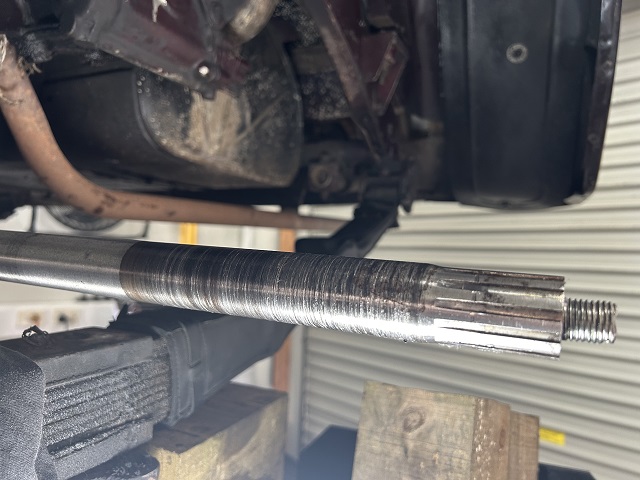 The corresponding area of the axle tube was also scored badly as in the photo below. 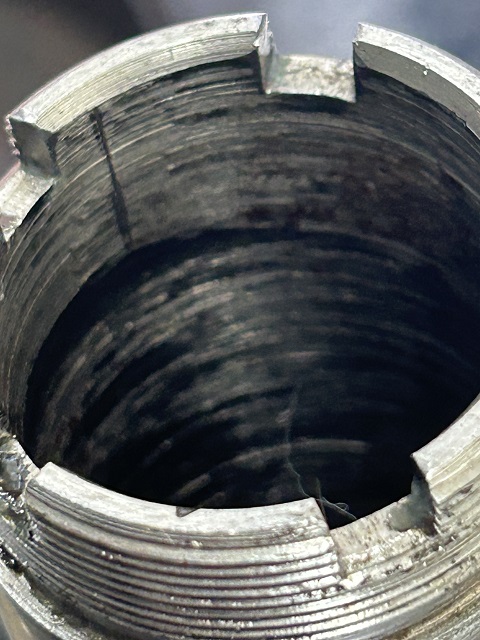 It appears that there may be at least one rivet end missing (see the row of rivets near the bottom of the picture). I have looked at this using my endoscope, but the picture quality is not good enough. I have another endoscope on order, so in a few days I might be able to get a better picture. 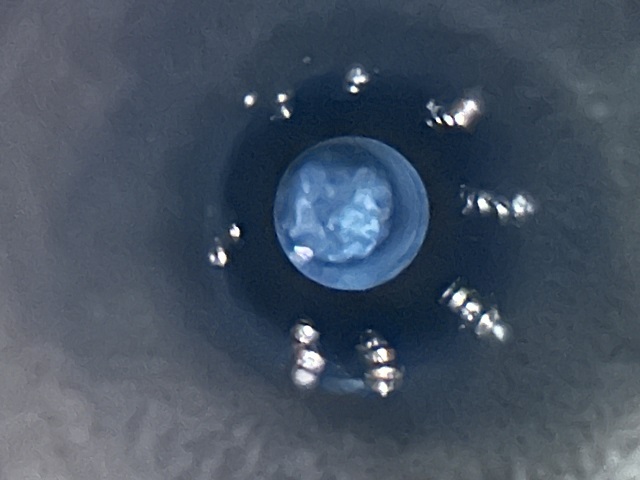 My theory is that at some stage the end of a rivet has become dislodged and worked its way into the thin end of the tube and caused the scoring on the axle and the tube. As the piece, or pieces, ground around the space between the axle and the tube, the movement of axle would have been enough to allow oil to pass through the seal on the differential. (Movement of the axle in this manner was suggested by Steve Sparks in one of our many discussions of the problem to be the cause of the leak without the seal being badly damaged). I am soon to remove the axle from the differential housing to see if there is any damage in the differential itself which could have allowed the oil into the tube and eventually into the brake drum. I was lucky, that 9 years ago, Steve had installed grub screws in each of the axle tubes near the differential. After removing the grub screws when I was first aware of a problem, I found that the oil was only leaking on one side of the differential. Eventually I will have to look at the Right Hand side axle and tube to see if a similar situation could exist. If anyone has any thoughts about my problem I would much appreciate them. I am sure that there are other possibilities that I haven't thought of yet. I guess I should expect to encounter these sort of things with the mileage I have been travelling lately. I had done over 8,000 miles in WXA68 in the 12 months prior to this problem. | ||
Koen Dierckxsens New User Username: prewarrb Post Number: 12 Registered: 04-2024 |
Dear John, First of all: my condolences for what has happened. Secondly, IMHO you and Steve Sparks may be very correct in establishing the cause of the oil leak. If another trivial cause could have existed (hole in tube, oil spill chassis lub or jacking system, whatever, ), I presume you would have noted that quod non. You have the hardware in your hands - then I will not venture into other reasoning. When heavily accelerating/braking strong torsional forces are exerted on the axle as a whole, pushing the nose (pinion) of your axle up or down. These forces are restrained by brackets over the axles and the springs you will know all this, I guess. Your rear axle has got two spring suspension brackets (=brackets with a sleeve, one L one R), that have been pushed over your axle tubes and subsequently solidarized both together with rivets (your definition). The rivets are not rivets but K4849 taper pin. This taper pin is ½ long (over all), this taper pin starts with an OD of ¼ and gets smaller following a taper, I quote: 1 in 48 on diameter. Each chassis would need 56 of these taper pins 28 on each side. Brackets would have been pushed over axle tubes, then final drilling and reaming (28 holes, just a little smaller than ¼ I guess), followed by pressing (hammering?) taper pins in position. So, in an ideal world, your photograph would have shown 28 lumps. Note, not all rows count 4 taper pins presumably you will be able to see where taper pins are missing / sheered off? If needed I can help you with position of these pins. Taking into account your full story, I wonder if your suspension brackets are still well solidarized to your axle tubes (no tangential movement should be possible), and your idea about checking the other side makes a lot of sense to me: if tangential movement of spring brackets is at stake, the other side takes full load ? Also: inside differential LH side is very different from RH side (crown wheel). LH side is more prone to oil washing, RH side may keep more dry, but same problem with taper pins may be there? John, you did write the amount of oil spill was considerable. The max oil level is well below bottom of inspection cover and also below the main differential bearing and axle shaft oil seal that is even higher. Yes, It is always possible minimal quantities of oil may pass through this oil seal, but it should be very limited and stay in the bottom of the axle tube, ready to be evacuated when removing your grub screws I think so. Could it be there was way too much oil in your rear axle? Or your car standing on a side slope? Or... ? Regards, Koen | ||
John Rowney Experienced User Username: johnrowney Post Number: 189 Registered: 02-2015 |
Many thanks for your information, Koen. I got a better endoscope and it appears that all the taper pins are intact, although there is a lot of metal from the drilling next to them. Maybe some of this has dislodged in the past. I have decided to remove the differential and have purchased a transmission jack. I should have the right hand tube off early next week (my wife has me fully occupied until then). The suspension brackets didn't have any movement in them, but the upper rubber insert between the springs and the tube was damaged. I have ordered new rubber inserts from Fiennes, as well as a replacement left hand axle. I am hoping to get the Fiennes' parts next week - I have paid the import duty etc to UPS so the package is in Australia. | ||
John Rowney Experienced User Username: johnrowney Post Number: 191 Registered: 02-2015 |
I have now removed the differential with the two axles attached. I have removed the right-hand tube and the following photo is of the right-hand axle in the hub area. It is pristine with no scoring and the engravings are clearly visible. 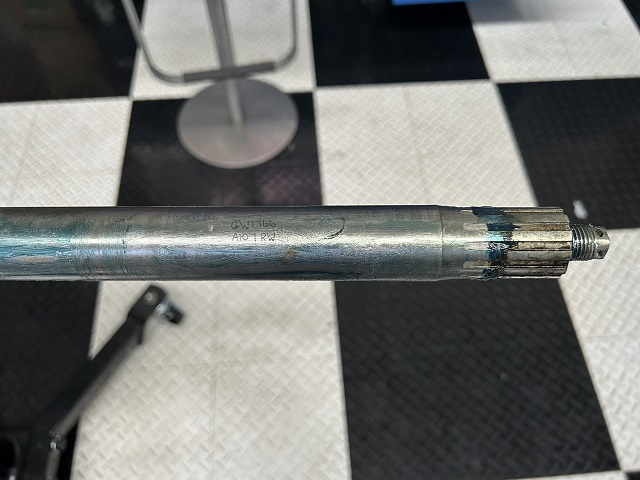 It is surprising that the RH axle tube shows signs of scoring - perhaps this is from a previous problem. See the photo below. 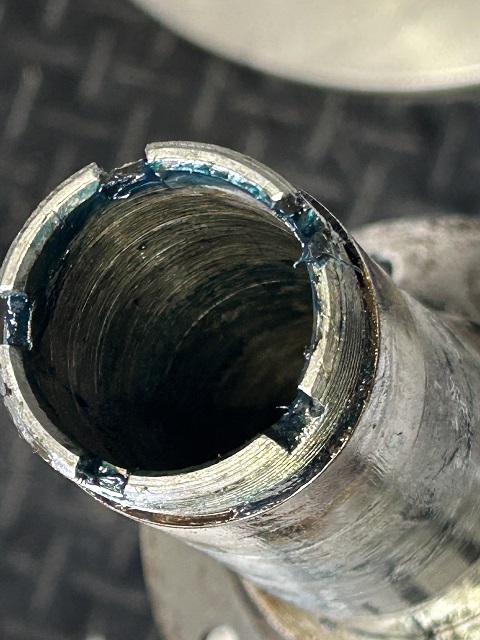 I am also able to take pictures of the inner area of the RH axle tube with my new endoscope. The photos aren't all that clear, but better than nothing. The photos are taken with my iPhone of the endoscope's screen. The photo below shows the typical look of some pins and the metal extending into the tube from the drilling process. 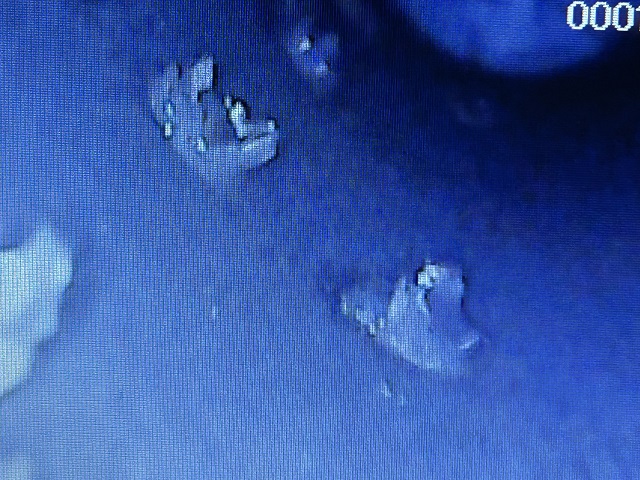 With the differential removed, I should be able to remove the LH axle. However, I am in a quandry - the drawings from the SHRF CD is limited and I am unsure how I get the axle out. I have blown up parts of the drawings and pasted them together. It is virtually impossible to understand the drawings completely - lots of the parts are given a number without a description. I am away for a few days, but I will pester Steve Sparks next week for more advice. Any thoughts on all this would be much appreciated. | ||
ChristopherCarnley Unregistered guest Posted From: 81.151.31.170 |
The axle is a fully floating type, it is almost identical to the Derby Bentley in construction, and indeed the Bentley tools are used to dismantle it. The driving bevels are part of the half shaft and machined on the inner end, such that you will have to split the differential to get them out. Beware, as the internal parts are all set by PB washers of varying thicknesses. There are also serrated left and right hand threaded nuts holding the bearings and parts together. I rebuilt one a few years back just to renew the seals. I will look out some pictures. It is nothing like the R-R 20/25 axle. (Message approved by david_gore) | ||
Koen Dierckxsens New User Username: prewarrb Post Number: 14 Registered: 04-2024 |
John, Inner diameter of axle tubes (at their ends) is 1.4". Outer diameter of axle shafts (at the same place) is 1.3". Result: there is NO interference fit between tube and axle at their ends. Result: internal finish of axle tubes is NOT critical. Some makes of cars had the stupid habit of taking a lot of care to the finish of their parts, even when this does not make (technical) sense at all. RR was much smarter: no waste of time/effort to finishes that are not critical. Result: the internal (poor - scored) finish of the axle tubes you found Left and Right, could well be result of original production process. Note also the internal finish of taper pins (rivets) is not that beautiful either, is it not? The same reasoning does apply here. You mention: "With the differential removed, I should be able to remove the LH axle." I was rather puzzled here, as I thought LH axle was already removed?!? As a result I do not understand your real needs here. If ever you can explain better, I may be able to help. Perhaps you can post the drawings/parts you have difficult with? Even if blurred it may explain better? Your turn  Best regards, Koen, | ||
John Rowney Experienced User Username: johnrowney Post Number: 194 Registered: 02-2015 |
I have been away for a couple of months and returned home about 6 weeks ago. It took a while to get over jetlag etc and lots of socialising before I got back working on the Wraith. Koen, no I hadn't removed the axles at the stage I previously wrote. I really didn't fully understand how to pull things apart, even though the diff assembly was fully removed from the car. I found articles on removing and repairing a PIII diff in some old PIII Technical Society "Phantoms" periodicals by Matt Pickles (issues no 84,85 and 88). I also watched Tim Jayne's YouTube videos on restoring his PIII and received technical information from Steve Sparks on the Derby Bentley rear axle. Between all these publications and advice from Steve Sparks by phone, email and SMS, I finally got the diff apart. I bought a new near side half shaft from Fiennes, since earlier I was uncomfortable with the scoring at the hub end of the axle. However, when I received the new axle, it showed signs of pock mark damage as below. 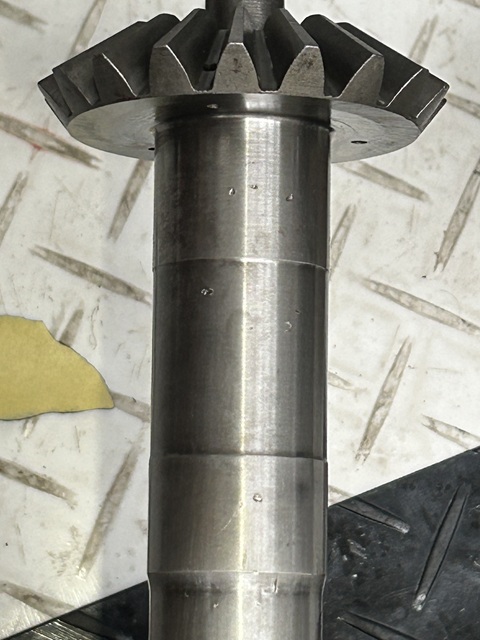 The worst feature of the damage was in lowest pock mark which is where the oil seal sits. I then sent the axle to be repaired by a local firm which is an expert in HVOF repairs. The company used a nickel spray to repair the damage, and the finished axle is shown below.  Fiennes generously compensated me for the additional costs involved in repairing the damage on the axle they supplied - Emily Anderson was extremely easy to deal with to overcome this issue, and Fiennes have taken additional quality control measures to ensure that this sort of thing shouldn't occur in future. I then saw that the offside axle had a groove and a noticeable lip (by touch), and following a recommendation by local RR expert, Colin Brown, I got this repaired by the HVOF experts as well. The groove marks on both axles prior to repair are shown in the photo below.  My thoughts now are that the grooves on both axles were probably caused by old, non-leather oil seals which cut into the axle. Steve Sparks had installed the leather seals 9 years ago, so it is uncertain when/if non-leather seals were installed The nearside axle leaked first, and that there was a good possibility that the offside axle would leak at some stage in the future if it wasn't repaired. Putting everything back together was a little bit more straightforward, since I had had the experience of pulling the diff apart eventually. I am up to the stage where I am waiting for a new tab washer from Fiennes, since the old one for a castellated nut holding the near side bearing in position lost one of its tabs as shown below. The other tabs looked rather dodgy as they would have been worked backwards and forwards a number of times over the past 87 years.  So here I am, waiting for a washer, which will take a week or so to get here. I will keep you informed. |